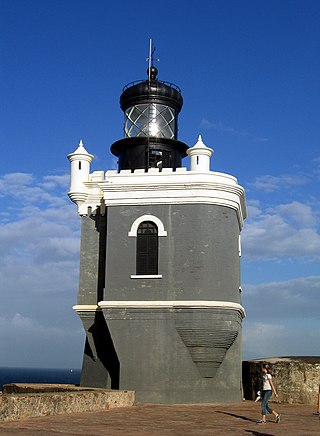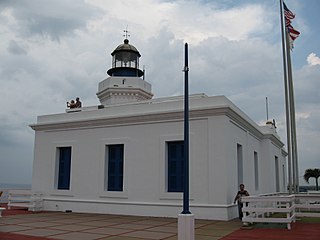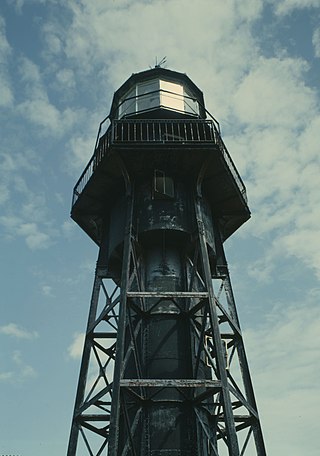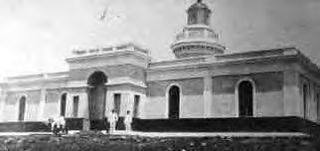
Fajardo is a town and municipality-Fajardo Combined Statistical Area.

Faro Los Morrillos de Cabo Rojo, also known as Los Morrillos Light, is a historic lighthouse located in Los Morrillos cape in the municipality of Cabo Rojo, Puerto Rico.

Ángel Rivero Méndez was a Puerto Rican soldier, writer, journalist and a businessman. Rivero Méndez was a Captain in the Spanish Army during the Spanish–American War and is credited with ordering the first shot against the United States in Puerto Rico in said conflict. After the war, he became a US Citizen and upon his retirement, he wrote Crónica de la guerra hispano-americana en Puerto Rico, a chronicle of the Spanish-American War in Puerto Rico. He is also credited with inventing the Kola Champagne, a carbonated soft drink.

Castillo San Felipe del Morro Lighthouse, also known as Faro de Morro Port San Juan Light by the National Register of Historic Places and colloquially Faro del Castillo del Morro and Puerto San Juan Light, is a lighthouse atop the walls of Castillo San Felipe del Morro in Old San Juan. It's the first lighthouse built in Puerto Rico.
The Conservation Trust of Puerto Rico is a private, nonprofit organization protecting natural areas; constituting conservation easements; restoring, rehabilitating and preserving historical structures; developing educational programs that foster the protection of natural areas; and directing a tree nursery program for native and endemic species, among others. The Conservation Trust of Puerto Rico has been accredited by The Land Trust Accreditation Commission. The Conservation Trust is also a member of the International Union for Conservation of Nature, a global environmental organization with more than 1,200 public and private members from 160 countries.

Arecibo Light is a historic lighthouse located in the city of Arecibo, Puerto Rico. It is also known as Los Morrillos Lighthouse because of its location on top of a rocky headland known as Punta Morrillos. The lighthouse was constructed and was lit in 1898. This was the last lighthouse built by the Spanish government on the island.

Punta Higuero Lighthouse, also known as Faro de Punta Higuero, is an historic lighthouse located in Rincón, Puerto Rico. The original building was built in 1892 by the Spanish government and was rebuilt in 1922 by the United States Coast Guard.

Punta de las Figuras Light is an historic lighthouse located in Arroyo, Puerto Rico. It was first lit by the Spanish government in 1893. The light was relocated in 1938, and the structure was deactivated and abandoned. During World War II, the lighthouse was used as a lookout. After the U.S. Army abandoned the structure in 1963, the lighthouse was repeatedly vandalized. In 1969 the lens and lantern were destroyed. The lighthouse was again damaged by Hurricane Maria on September 20, 2017. The light housing is broken, all of the windows are boarded up, and several of the surrounding light pole fixtures are downed. The interior is currently inaccessible.

Cardona Island Light is the only 6th order lighthouse in Puerto Rico with a cylindrical attached tower. The light is located on Cardona Island, a small island on the west side of the entrance to the harbor of Ponce, Puerto Rico. It was listed in the U.S. National Register of Historic Places on 22 October 1981.

Punta Tuna Light is a historic lighthouse located in the southeast of the town of Maunabo, Puerto Rico on a narrow promontory at the southeasternmost point of the island. It was first lit in 1892 and automated in 1989. The light was a third-order lighthouse that served as the primary light connecting the island's southern and eastern lights system. The design was drawn and laid out by Joaquin Gisbert in 1890. The lighthouse construction was initially overseen by Adrian Duffaut. It was built from March 13, 1891, to September 29, 1893. Final construction was taken over by the Spanish Body of Engineers according to annotations of the historian Carlos Moral. It was originally named Faro de Mala Pascua after the cape to the west. Later, it was moved and renamed after the Point of the construction site so the light could perform a double duty warning ships off the Sargent reef. On August 8, 1899, the lighthouse suffered damage from Hurricane San Ciriaco; the town suffered heavy damage. On April 12, 1900, an act of Congress extended the jurisdiction of the Lighthouse Service to the noncontiguous territory of Puerto Rico and adjacent American waters. 1900 The Lighthouse Board took charge of the Puerto Rico lighthouses. September 13, 1928, Devastating Hurricane San Felipe II strikes, again the lighthouse stands firm, but the town housing is nearly totally destroyed. It was once again damaged by Hurricane Maria on Sept 20, 2017. The light's housing, the external facade, and the surrounding vegetation were all damaged, with some trees completely downed. It was listed in the U.S. National Register of Historic Places in 1981. In 2007, the government of Puerto Rico bought an area near the lighthouse to create a conservation area. The structure is being restored by the town of Maunabo and is open to the public. The light is not working and the lens appears to be missing. The lighthouse in a state of disrepair and locked, but one may still view it from the surrounding property.

Punta Mulas Light, also known as Faro de Vieques, is a historic lighthouse located in the north shore of Vieques, an island-municipality of Puerto Rico. It was first lit in 1896 and automated in 1949. Punta Mulas Light was the second lighthouse built on Vieques after the Puerto Ferro Light. The light was established to guide through the dangerous passage formed by a chain of reefs. It was of key importance for navigation in the San Juan Passage.

Mona Island Light, also known as Faro de la Isla de la Mona, is a historic lighthouse located on the island of Mona, Puerto Rico, in the Mona Passage between Puerto Rico and the Dominican Republic. It is the only lighthouse built of iron and steel in Puerto Rico. While some sources reported that the structure was designed by Gustav Eiffel, who also designed the Eiffel Tower in Paris, recent studies have shown that the tower was designed around 1885 by Spanish engineer Rafael Ravena.

Guánica Light was a historic lighthouse located in the town of Guánica, Puerto Rico in the Guánica State Forest. It was first lit in 1893 and deactivated in 1950. The light marked the entrance to Guánica Bay and bridge the gap between Los Morrillos Light and Caja de Muertos Light.

Punta Borinquen Light is a lighthouse located in the old Ramey Air Force Base in Aguadilla, Puerto Rico. The station was established in 1889 by the Spanish government. With the opening of the Panama Canal in 1914, the lighthouse would become "the most important aid to navigation on the route from Europe to Panama". In 1917, the U.S Congress provided funding for a new lighthouse in higher ground.

Puerto Ferro Light, also known as Faro de Puerto Ferro, is a historic lighthouse located in the Vieques, Puerto Rico. The light was first lit in 1896. It is one of the last minor or local lights to be built by the Spanish government. The light was of crucial importance to cross the Vieques Passage. The lighthouse was deactivated in 1926 when it was abandoned.

Isla Cabras Light, also known as Faro de Isla Cabras, was a lighthouse located on a rocky but flat islet with the same name, which sit just off the coast near Ceiba, Puerto Rico, toward the Vieques Passage.

The Battle of Fajardo was an engagement between the armed forces of the United States and Spain that occurred on the night of August 8–9, 1898 near the end of the Puerto Rican Campaign during the Spanish–American War.
Beatriz del Cueto is a Cuban-born architect specialising in conservation and architectural preservation. A resident of Puerto Rico since 1960, del Cueto is a Fellow of the American Academy in Rome, Fellow of the American Institute of Architects, and Henry Klumb Award winner in 2012.

Culebrita Lighthouse is the only remaining Spanish-era structure in the Culebra archipelago. Construction of the lighthouse began on September 25, 1882, and was completed on February 25, 1886. The Spanish Crown built the lighthouse to help secure its claim over the main island of Culebra. It is the most eastern light outside mainland Puerto Rico. It guided navigation through the Virgin Passage and the Vieques Sound connecting in the Puerto Rico Light System with the Cape San Juan Light.






















